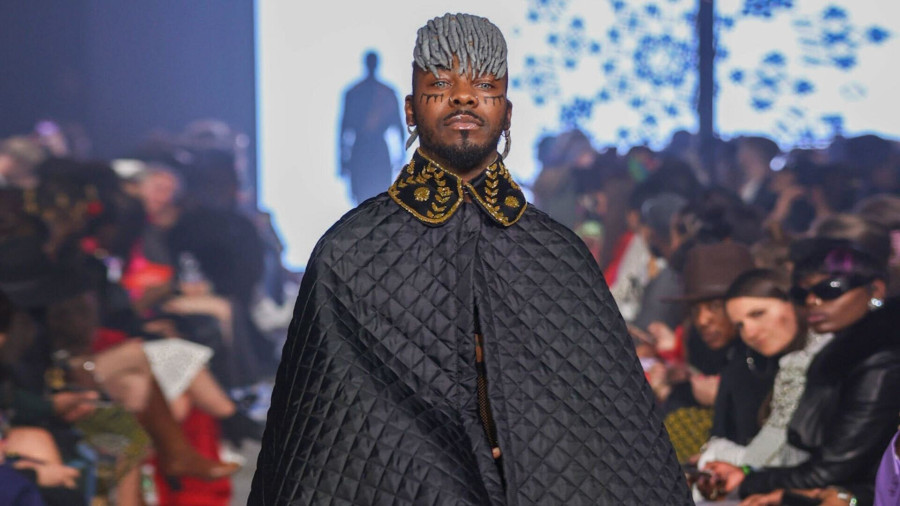She is the founder and head designer of Annafora. Ghide showcased her latest collection of 12 at Fashion Art Toronto’s Spring 2023 show. She named the collection Ahadu, which means “one” in Ge’ez (an ancient Ethiopian language) and symbolizes the Trinity, coming together as one.
Ghide's show allowed the audience to explore Ethiopian and Eritrean history from a unique and vibrant perspective. She tried to capture over 3,000 years of history by characterizing significant figures from her ancestral countries, Ethiopia and Eritrea. These figures include the Queen of Sheba, Emperor Menelik II, and Emperor Haile Selassie I. By doing so, she celebrates the rich history and culture that connects the two countries and inspires unity and togetherness rather than division.
Ghide’s show was a sight to behold. The models moved gracefully on the runway embodying the Ethiopian royals with clothes and accessories infused with traditional materials and symbols. To complete the experience, the air was filled with modern Ethiopian instrumental music by Mulatu Astatke, the father of Ethio-Jazz.
“The goal is to showcase the beauty and resilience of the Habesha community during a time of conflict and uncertainty. The ultimate message is to replace conflict with progress and envision a future where different cultures can connect and thrive,” explains Ghide.
She adds, “Ethiopia and Eritrea have many beautiful cultures that we try to combine in our work. One culture isn’t better than the other. Everything works in harmony, and we act with peace and honour.”
Additionally, Ghide wants her collection to depict wider African history.
“Growing up in Toronto, we didn’t learn about Emperor Menelik, Queen of Sheba, and others. ”My father often told me about Ethiopian and Eritrean history, but there was only so much he could say to me until I went to figure it out for myself. There is more to our story that people today need to know,” she argues.
The good news for Ghide is that she received positive feedback from the show. “Some people in the audience gasped in excitement at seeing my work. This exposure made me more optimistic because many young people reached out to me with gratitude,” she says happily.
{https://www.instagram.com/p/Crl29b4gZoq/}
Putting a personal spin on fashion
Growing up, Ghide was always fond of having nice clothes and would try sewing for her dolls at home. She earned a small income by selling handmade items to her friends, neighbours, and sisters. As she got older, she started volunteering in her community and school. She also made prom dresses for herself and her friends. At the time, she didn’t plan to monetize her skills and only pursued fashion as a hobby because her parents felt it wouldn’t be a reliable career.
The ball started rolling
Ghide got her first opportunity to work on a collection when her friends showed her designs to a small local fashion show host. This allowed her to get more involved in the industry.
Ghide cherishes all her mentors, including Theodora Bak from Italy. She fondly remembers her experience at a few garment factories in Toronto, including her experience at Ling May Apparel.
“That was a turning point for me because it helped me gain first-hand experience related to manufacturing processes in the fashion industry,” she explains.
{https://www.instagram.com/p/CrlqSCZLbcP/}
Telling stories with clothes
Ghide’s style depends on the story she’s telling. At times, she likes focusing on culture, and at others, colour or nature. Most of her inspiration comes from politics and history. She prefers to work with natural fibres like cotton, silk, and wool.
“Sitting down and sewing is a laborious task. But when the project comes together, it feels amazing, and all your hard work pays off. What’s even more rewarding is to see people wearing your designs.”
Taking the plunge
Ghide wanted to expand her understanding of the fashion industry in Canada and gain more experience. But the journey was challenging because there were few opportunities for her as a Black fashion designer. She explains that while Black modelling may be highly celebrated now, it’s rare to see Black people in positions of authority.
Eventually, she established Annafora in 2014. Annafora is a luxury design company that combines natural fibres with avant-garde designs. Annafora designs both menswear and womenswear.
“Each piece of Annafora clothing is a work of art with a unique story to tell through innovative designs and traditional African fabrics,” Ghide introduces her company proudly.
She cites two reasons for establishing the design company. Firstly, she struggled to secure a space in the primarily white-dominated industry, and secondly, she wanted to help other Black designers.
“I applied to many jobs in the Canadian fashion industry, and the response was very lukewarm,” she explains before adding, “While I can't blame this unfortunate turn of events on my race, there is no denying that racism has played a big role.”
There were times when Ghide felt pessimistic about her business. Besides the obvious marginalization due to her skin colour, Ghide also states that securing funds for fashion shows is a challenge in Canada.
“Fashion doesn’t always qualify for Arts Council grants. We are given different definitions depending on whatever is convenient to the powers that be. For example, the business community says we’re not a real business, and the art community says we’re not real artists,” says Ghide as she explains the conundrum.
In addition, Ghide claims that the American and European markets are more receptive to Black fashion designers than Canada.
“As a designer, you're dealing with Canadian retailers not ready to take on new risks. They would rather invest in well-known brands like Adidas or Nike,” she explains.
{https://www.instagram.com/p/CJrGjkVgSSY/}
Her other concern is the tendency of Black people not to support and encourage emerging designers in their community.
“Black people love high-end brands or brands advertised in the media. So we have to take the initiative of celebrating the work of emerging designers,” suggests Ghide.
Ghide finds a glimmer of hope in social media and believes it plays a huge role in fashion.
“Some people don't need a web store or a retailer. They simply sell their products on social media. This has also been the case for me. Without social media, I, too, would have no opportunities,” she explains.
Challenges in promoting African fashion in the West
Ghide states that Africans actively support the industry as consumers, spectators, models, and producers. So the only thing left is to get more acceptance and a better pay rate.
“The Made-in-China label is highly understood, but Made-in-Ethiopia or Made-in-Nigeria isn’t. Why?” asks Ghide. She answers, “It's not that our people don't have the experience. We've been producing textiles and garments in our communities for years. So why not accept us as producers now?”
{https://www.instagram.com/p/B61fRYpnSDx/}
Ghide believes this goes back to the policy and political systems of African countries and how people engage in foreign and international markets. She adds that the bridge between African countries and the Western world must be built on a solid foundation for fashion design work to flourish.
“The fashion industry, specifically in Ethiopia, cannot flourish without peace and stability in the region,” she asserts.
Wisdom for aspiring fashion designers
Ghide’s motto is “Don't push it off till tomorrow if you can get it done today.” She believes that two things are essential to be successful in this industry. “First, you must understand how business works because fashion is about selling products. Secondly, you need teamwork and delegation; otherwise, you’ll quickly experience burnout if you do everything alone.”
She also believes that one must be mindful of their health along the way. Taking care of oneself and being able to take breaks, and be patient are some of the most important things she does for herself.
She has a few words of encouragement and advice for aspiring designers, “Get started now! Don’t allow perfectionism to prevent you from making a start.”
What’s next for Ghide?
Ghide plans to do more shows and get her work out in front of retailers to keep growing and expanding her horizons. She also wants to emphasize the commercial side of things to maximize the impact her work has on the people she is working with. Ghide also hopes for peace and stability in Ethiopia because her heart is set on expanding production there.
“The biggest reward is when you have a business that makes a difference in other people’s lives. It’s an incredible feeling. There are so many talented people who just need a platform to work with. I was given an opportunity. And I want to pay it back.”

 By
By 





